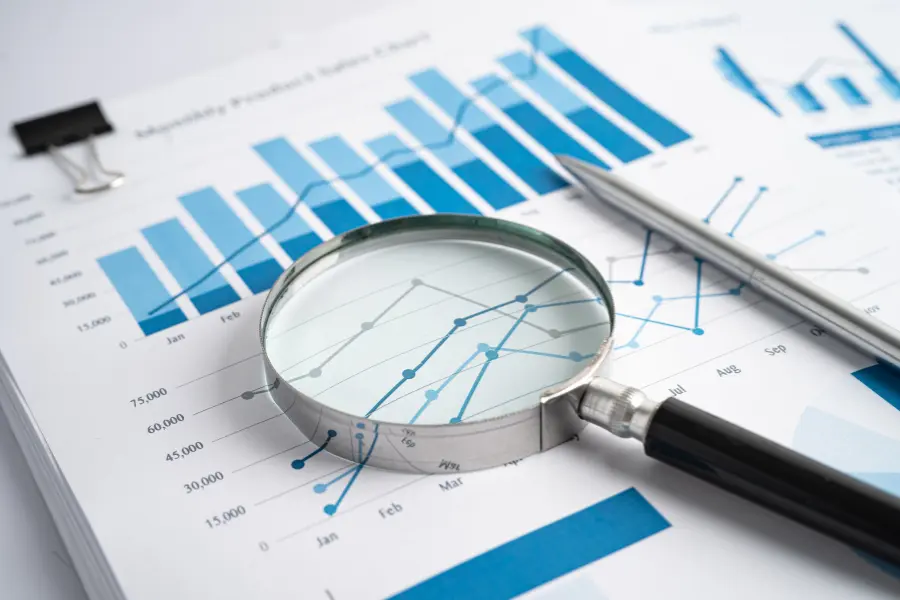- Need Free Consultation?

In the competitive landscape of modern business, having the best project management requires more effort than solid plans and controlled execution. The secret weapon? Data! By harnessing the power of data, organizations can look into the future and foresee possible issues, make quick decisions, and ensure projects succeed on time and within budget.
Get ready to collect insights on data analytics and how its function is more than an addition but a necessity for smooth project performance. Discover the strategies and tools to turn data into your most valuable asset.
Data analytics examines raw data to draw practical conclusions and prevent possible challenges. The power of data analytics is significantly underrated; it is surprisingly similar to having a scrying mirror that predicts future hurdles and provides real-time solutions. It helps project managers to make informed decisions, anticipate risks, and plan the whole work process more effectively

Data Collection: The foundation of any analytics work is a rich data collection. That includes relevant data from outer sources or inner ones such as project logs, time sheets, budgets, etc. The beginnings of data analysis will look like assembling a complicated puzzle, where every bit of data will eventually become part of the bigger picture.
Data Analysis:Once the data is collected, the next step is to process it. This is where the magic happens, and a huge jumble of patterns and information comes together to create a clear, actionable plan.
With data analytics, you gain a 360-degree view of your status at any time. Real-time dashboards and reports provide up-to-date information on progress, and KPIs. It is a bird’s-eye view of your project landscape, highlighting the milestones and potential pitfalls.
Anticipating and softening the landing of any pitfalls is crucial to successful project management. This proactive approach, evoked by data analytics, helps identify any mishaps in the early stage of production and make an action plan just in time.
Data analytics boosts overall motivation and efficiency by eliminating issues early on. Well-timed resource allocation leads to better performance and productivity rates, which eventually result in faster project completion times and budget savings.
The days of manual data entry are gone. Automated data collection tools, such as PM software, time-tracking apps, and IoT devices, can quickly gather and update data with minimal error rates in seconds. Save your valuable time by allowing your data to flow seemingly into your system without lifting a finger.
Projects often involve diverse data sources, from financial records to team communications. Integrating this data into a unified system is essential for comprehensive analysis. Utilize APIs, data connectors, and integration platforms to merge data from different systems into a centralized database. This holistic view enables better insights and informed decision-making.
Descriptive analytics involves summarizing previous data in your past projects. Tools like dashboards and reports help visualize this data, making it easier to comprehend. Think of it as your project’s rearview mirror, giving you a clear picture of past performance to inform future actions.
Predictive analytics uses statistical models and machine learning to forecast outcomes. The implementation of modern technologies makes this method one of the most effective and close to truth in our times.
Prescriptive analytics combines data, algorithms, and machine learning to suggest the best action for future projects. This approach predicts outcomes and prescribes solutions to optimize project performance.
KPIs are the benchmarks that help you measure the success of your project. By defining and tracking KPIs, you can evaluate whether your project meets its goals. Common KPIs include project completion rate, budget variance, and resource utilization. Data analytics enables you to set, track, and analyze these indicators in real time, providing a clear snapshot of project health. Think of KPIs as the vital signs of your project, constantly monitored to ensure everything is running smoothly.
Dashboards visually represent your project’s data, bringing together critical metrics and KPIs in one place. Real-time monitoring tools update this information continuously, offering instant insights into project performance. These tools can highlight areas needing attention, track progress, and forecast future outcomes.
Analyzing performance trends over time helps identify patterns and predict future project outcomes. By examining historical data, you can pinpoint recurring issues, forecast potential challenges, and adjust strategies proactively. Performance trend analysis offers deep insights into long-term project health and efficiency.
IBM, a global leader in technology, revolutionized project management using data analytics. Faced with complex IT projects, IBM integrated advanced analytics tools to enhance efficiency, predict risks, and ensure timely delivery.
IBM collected and analyzed data from various project stages, focusing on KPIs such as timelines, budgets, and resource utilization. Real-time insights and predictive analytics enabled proactive risk management and informed decision-making.
Early Integration: Integrate data analytics from the project’s start.
Invest in Tools: Use robust analytics platforms.
Continuous Training: Train teams in data analytics tools.
Focus on KPIs: Monitor the most critical metrics.
Using data analytics in project management is the key to transforming your outcomes forever (and for the best!). By integrating the techniques mentioned in this article in the early stages of your project and investing in worthy tools, you’ll succeed faster than ever. Your path to exceptional project performance starts now!
Contact Our Experts to Get a Free Consultation Today!